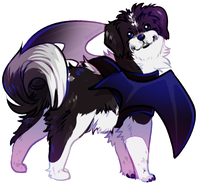
Pronounced Dough-mare
Domaer is singular and plural. Such as:
Individual: My domaer is gentle.
Plural: Look at all the domaer here!
Female domaer are called: Maers
Male domaer are called: Studs
Information about the species:
- A Domaer's body structure is built sturdy, and strong. They can be found in the wild, but may be tamed to ride. Their natural instinct is observe, but make themselves known. If the animal/ human looks weak, they won't attack (Unless it's prey) but, if the animal is carnivorous, and destructive, they will attack to defend it's self or to make itself look tough. They won't kill though. If they live together it's called a group. Not a herd like horses.
- A natural environment is usually in calm forests with a steady supply of birch trees for their bark. They usually live on flat ground, and get water supply from small streams. Though, because they can be tamed for a persons interest, they can live just as healthy in a stable or barn. They get along well domestic, though it may take time to adjust if you have chickens.
- Their diet is omnivorous, and can consist of grasses, and small prey. They usually hunt only when they have no grasses to feed off of. The bark on a birch tree is very nutritious and good for their joints. That is why they live near many birch trees in a forest.
If a person owns a domaer, they may want to supply sweet feed, daily turnout into a pasture with grass, and have logs of birch trees laying around for them to eat and gnaw on.
- When a domaer is domestic, they can be used for carriage pulling, plowing, riding, and can be taught tricks. They prefer to be in large open spaces, and not in a stall for too long. If it's overnight you can keep them in if it's cold, but if wolves are around you may want to keep them outside to protect your stable/ barn. You can ride them in a river as well, they are good swimmers with their powerful legs, but you should braid their long tail before entering the water. They do not respond to negative training, and you will go a lot faster if you have a great bond together. Whips, and such are useless. Spurs will only piss them off. They can jump, like show jumps and logs, but if the jump is too high, they will try and climb it, or run around it. No they can't climb trees, their body weight would snap the tree.
They can be taught these simple tricks:
- Sit- They are able to sit like a dog could, but sit awkwardly like a horse.
Shake- Can easily be taught to wave once shake is mastered.
Roll over- With their large bodies, it can take a while to achieve this trick.
Grab- They can stand tall on their back legs to grab something that is out of reach.
Hug- They will sit down, and wrap their paws around your neck.
Kiss- Tap on their nose and ask for a kiss.
Kneel- To kneel with both front legs folded, for smaller or disabled riders to be able to get up on.
Bow- Using 1 leg folded under they can achieve a formal bow.
Lay down- If children are present, it might be best to have them lay down to avoid children climbing too high or getting stepped on.
Fetch- Say you lost a toy or something, they are highly intelligent and can retrieve something for you. They must know what you are asking though, so if you ask them to go grab something they don't know or have never seen before they won't understand the command.
- Domaer can vary in size, but when calculated they are used in horse terms of hands. 1 hand= 4 inches. hh stands for hands high.
They are range from on average of 15hh-18hh.
- Domaer are very clean animals, and in the wild, domaer would groom each other and groom each others tails. Domestic domaer will depend on their owner to brush out their tail every day, twice a day too keep it from tangling up in snarls.
- Domaer mate for life. A baby is called a caph or plural- cavhs.
They always have 2 cavhs. You may choose to put them up for adoption after 2 weeks of them being created, or keep them.
1 caph will go to the owner of the mother, and the other to the father- unless one of them doesn't want the caph, a player may receive both cavhs, and may choose to put them for adoption or raise them on their own.
The cavhs will reach the same height as the shortest of the parents.
- There can be customs, but you will have to pay. You do not get to choose their markings, but only the base color and eye color.
- Base colors are similar to horses, but can vary to non realistic coat colors.
They will always have bird catcher spots, and very rarely have none.
Males will have colorful vibrant tails to attract females.
Females will remain natural.
If their paws are white/ very light colored, their paw pads will be pink.
If paws are black, or dark colored, their paw pads will be black.















